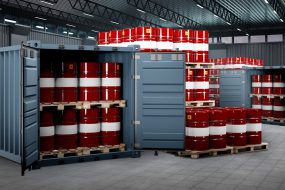

Omnichannel retail is a comprehensive strategy integrating multiple online and offline channels to create seamless touchpoints between retailers and their customers. This approach, driven by the digital retail revolution, allows customers to engage with brands across various platforms—whether through websites, mobile apps, physical stores, or social media.
As customers move across these varieties of channels, their data and applications also move along, offering them greater flexibility, convenience, and a more personalised shopping experience.
A successful omnichannel experience spans from online stores to in-store digital signage, point of sale (POS) systems, courier services, and kiosks, offering multiple touchpoints that can significantly boost sales. By engaging customers across these channels, omnichannel retail enhances brand loyalty and streamlines the customer journey.
How fashion supply chains work
The fashion supply chain is the vast network of systems and players in the industry responsible for transitioning fashion products—clothing, handbags, belts, shoes, accessories, and more—from concept to consumer.
Key players in the fashion supply chain include silk, linen, and cotton growers, textile manufacturers, logistics companies like Aramex UAE, freight forwarding agents, retailers, and distributors. A successful fashion supply chain runs a transparent communication model to enhance product quality and speed up the delivery process to the customers.
Evolution of Retail
Like many other industries, retail has experienced significant growth in recent years due to technological advancements and changing customer behaviours and preferences. Here is an up-close look at the traditional and omnichannel retail models.
Traditional retail model
Traditional retail models refer to the conventional approach of selling goods in a brick-and-mortar store. In this model, customers can physically experience items displayed in the store and judge the actual quality of products before settling on the most suitable option.
The critical players in this model include the manufacturer, wholesaler, distributors, supply chain network, retailers, and the consumer.
Emergence of omnichannel retail
Unlike the traditional retail model, today’s customers want more than just an experience for their daily shopping—they crave personalisation and convenience from a seamless shopping experience. With the rapid growth in technology, this has become a reality for many consumers.
According to Invoca, 81% of retail shoppers begin their purchase journey through online search—mainly through search engine queries—before eventually buying their products. About 77% of these shoppers are mobile surfers.
The rise of e-commerce giants such as eBay and Amazon has propelled many traditional retailers to provide their customers with online store options. The 2020 global pandemic was also instrumental in changing online shopping behaviours.
A survey of about 3,700 consumers across different emerging and developed economies records that more than half of its respondents say they now shop more frequently online due to the pandemic. Omnichannel strategies have helped more customers easily navigate different phases of the buyer’s journey—from online to physical stores.
Why Customers Continue To Find Value in Omnichannel Retail
Retail shoppers are increasingly becoming more accustomed to the hybrid shopping experiences and the value they offer, some of which include:
- Easy, uninterrupted customer journeys across a variety of touchpoints.
- Consistent expectations of trusted brands and seamless transitions all through the journey.
- Personalisation opportunities and improved connections with retailers.
- Increased purchase options beyond limited in-store assortments.
- Relevant recommendations based on previous purchasing records.
- More effective and reliable customer service.
Impact on Fashion Supply Chains
Increased complexity and demand for seamless integration
Omnichannel retail has introduced new opportunities and complexities to the supply chain. It enhances visibility and coordination across different fashion supply chain channels. However, it also brings additional operational requirements. Retailers must operate with real-time data on their order status, inventory levels, and deliveries to bolster a system that allows customers to shop seamlessly with the omnichannel retail model.
Related article: Supply Chain Logistics Barriers and How to Overcome Them
Inventory Management Challenges
The transition to inventory management using the omnichannel retail model comes with challenges that can make even an established retailer struggle. Some of these include:
- High storage cost of inventory.
- Real-time visibility across various deployed channels.
- Difficulty in integrating new technology with active systems.
- Difficulty in accurately analysing big data.
- Increased necessity to comply with data protection regulations.
Logistics and Fulfilment Considerations
The omnichannel model also demands faster and more flexible fulfilment options, whether customers want same-day or in-store delivery. This has extensively fueled the increase in ship-from-store and click-and-collect delivery methods. Notably, in the omnichannel retail model, businesses are now exposed to opportunities to leverage data and analytics to optimise their supply chain operations.
Technology and Innovation
Role of Technology in Enabling Omnichannel Retail
Technology enables omnichannel retailers to curate data, analyse it, and offer customers personalised experiences throughout the buying journey. Order management systems and other applicable technology allow businesses to provide real-time updates and impeccable order processing.
Adoption of advanced supply chain management systems
Integrating the appropriate supply chain management (SCM) software into a management system is crucial for any organisation considering enhancing its operational capacity and competitiveness.
Some critical factors to consider include estimating the actual ownership cost, prioritising shipping trackers and other industry-specific tools, evaluating the possibility of customising desired SCM software, and integrating compatible prospective solutions with the current IT infrastructure.
Related article: 5 Benefits of Digitalising Healthcare Supply Chains
Consumer Behavior and Expectations
Shift in consumer shopping habits
With the rapid growth in technology and increased social consciousness, consumers now seek authenticity mixed with convenience and speed. Retailers must understand this and adapt to it quickly. Some of the fundamental shifts to note include:
- Emerging digital touchpoints for shoppers’ engagement
- Priority is placed on social responsibility and sustainability
- Instant gratification with real-time inventory and increased freight forwarding speed
- Personalisation, balanced with privacy
Demand for Personalised Experiences
A research study on 1,905 retail consumers and 1,749 hotel guests uncovered a strong link between personalisation and satisfaction. This indicates that more consumers will willingly spend more if businesses offer them more customised experiences.
Future Trends
Anticipated developments in omnichannel retail
The omnichannel retail experience that comes with connecting your offline and online channels has become a necessity, and here are some anticipated developments to help you stay ahead of the curve.
- Retailers are now optimising customers’ mobile experiences with apps and websites to boost sales and retain customers by integrating loyalty programmes and online payments.
- Artificial Intelligence (AI) is becoming a much bigger player, with virtual assistants and chatbots leading the charge in providing customers instant support throughout their purchasing journey.
- Filters and AR are moving beyond simple overlays to bring the in-store experience online.
- Consumers are increasingly prioritising sustainable practices with brands.
Related Article: How Global Waste Management is Becoming More Sustainable
Potential Impact on Fashion Supply Chains
An omnichannel strategy in fashion supply chains integrates communication and sales touchpoints that consumers leverage. This helps businesses fuse the strengths of each channel to boost the overall customer experience with increased convenience, cohesiveness, and consistency.
Therefore, it is important that fashion retailers carefully maintain consistency in their visual identity, messages, and customer service across all channels and touchpoints.
Key Takeaway
The omnichannel retail and fashion industry is dynamic and fast-paced, requiring careful implementation of its supply chain. There has been an upward shift in technology and customer behaviours, with consumers now prioritising convenience and a customised experience across touchpoints.
The effect of omnichannel retail on the fashion supply chain will depend on the evolution of transportation, production, customer preferences, and experiential technologies across touchpoints.
Aramex Dubai has actively participated in providing customised logistics solutions to help businesses reach more consumers regionally and globally. Contact us atAramex Dubaito learn more.




